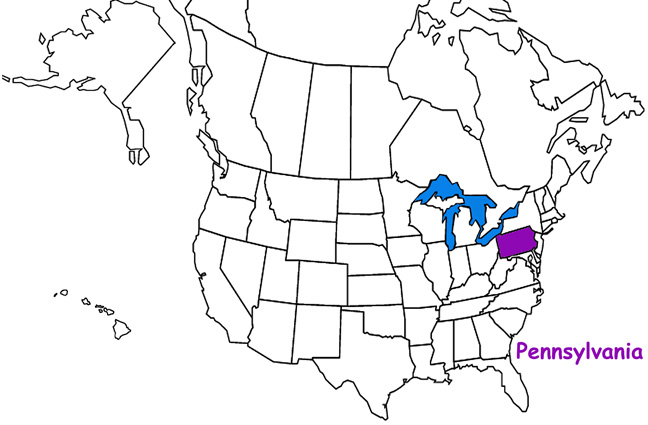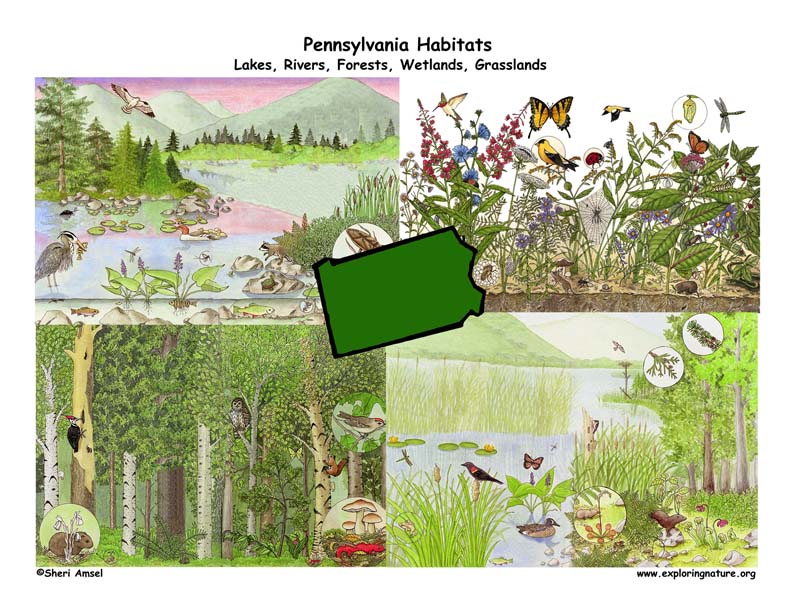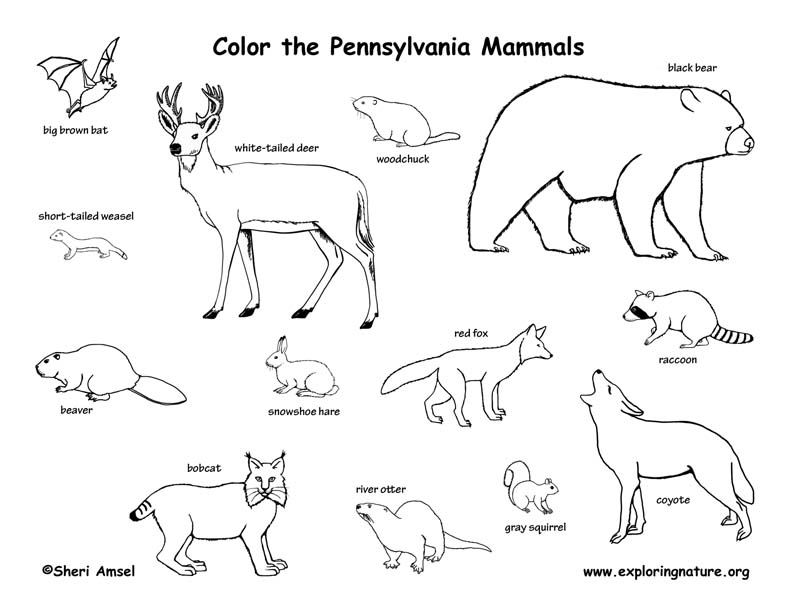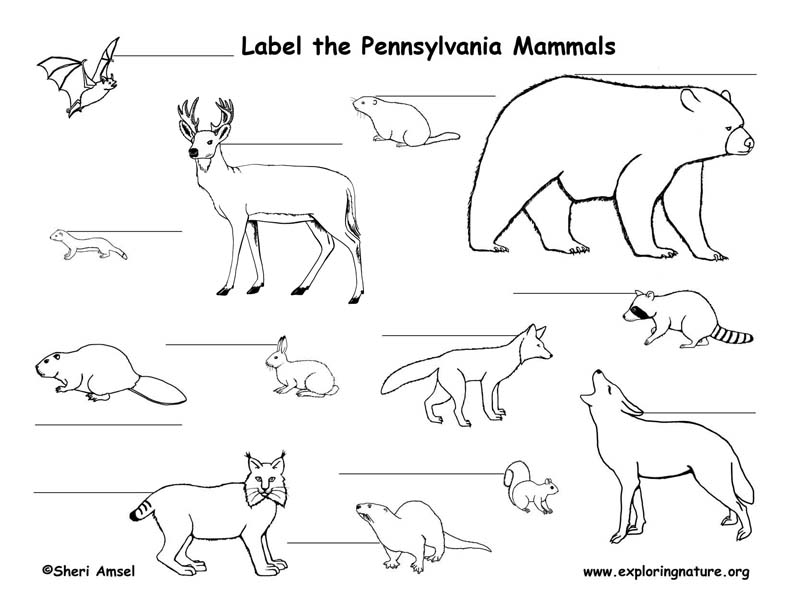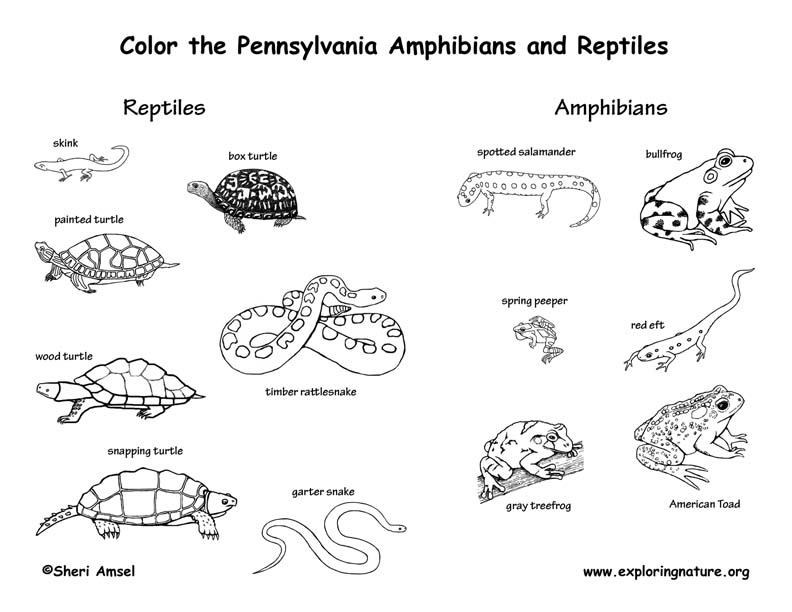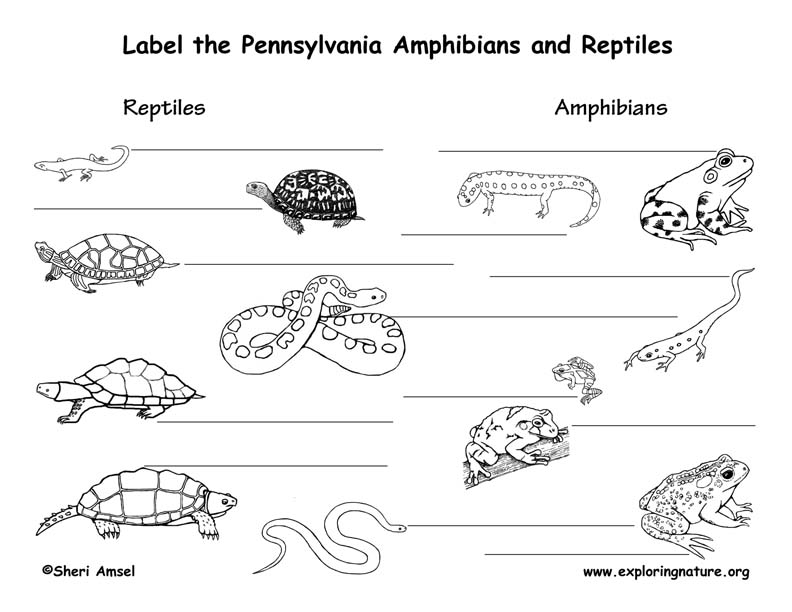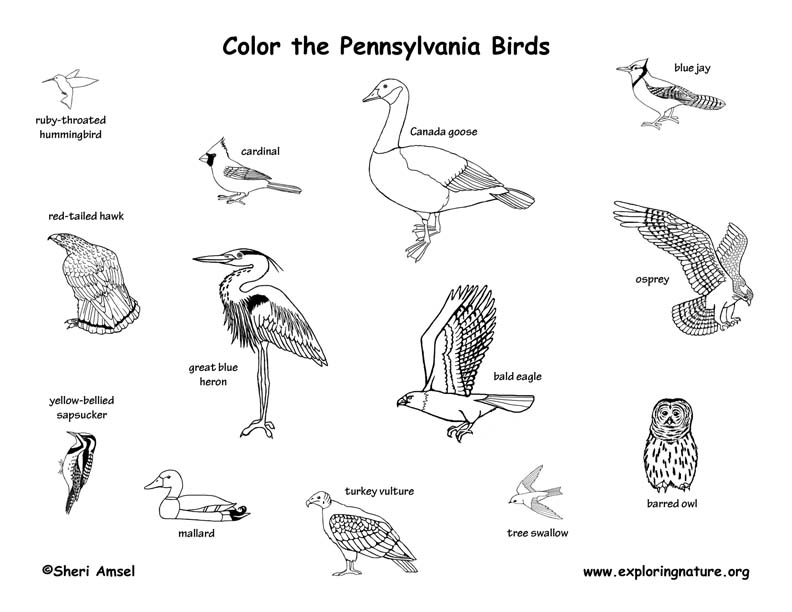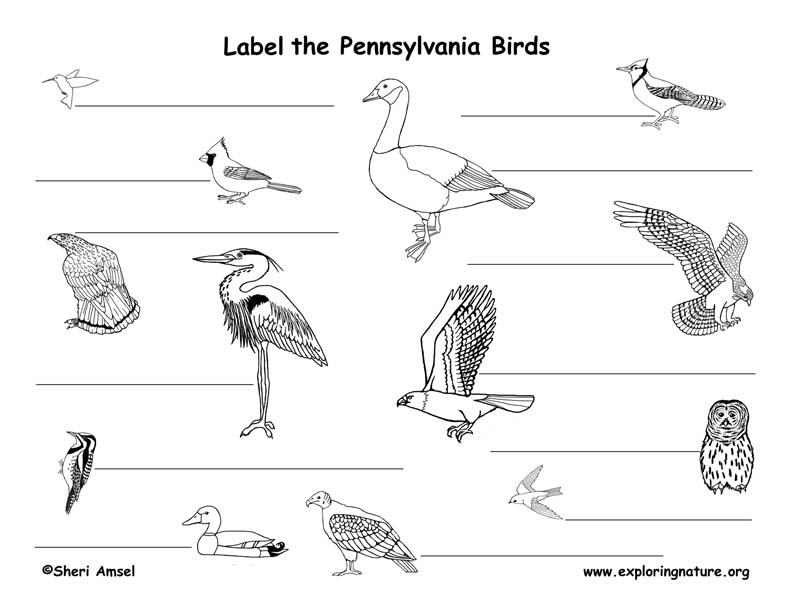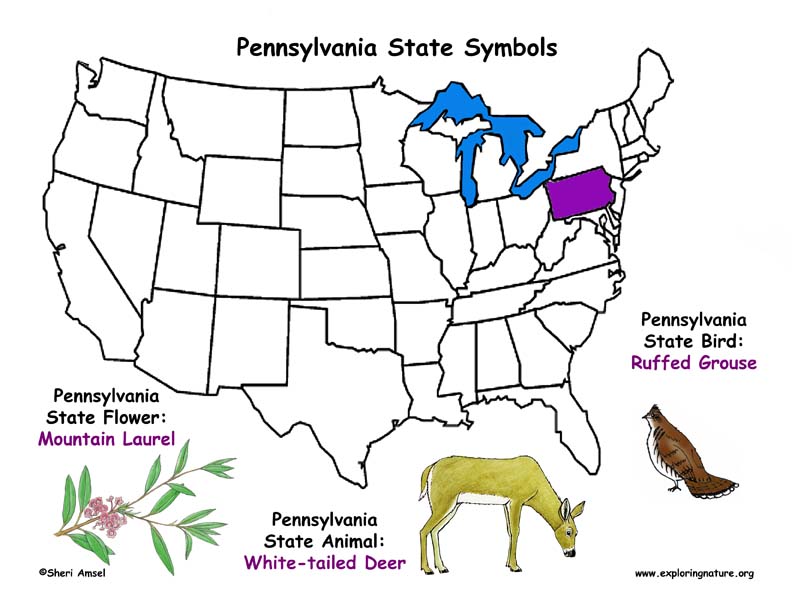

Forests
Forests cover more than half of Pennsylvania and more than half of those are deciduous. Different kinds of deciduous forests are named by the dominant trees that live there. About half the deciduous forests are oak-hickory forests. The next largest forest type are northern hardwood forests. Other common deciduous trees are black cherry, red maples, aspen, birch, ash, and elm, silver maple, sycamore, black willow, river birch, pin oak, ashes, hawthorns and box elder. Coniferous forests make up a smaller portion of the Pennsylvania forests, but are important for the animals that winter there like, white-tailed deer, ruffed grouse and black-capped chickadees. The coniferous trees include hemlock, white pine, red pine and red spruce. Other animals found in forests and on the edges of forests in thickets include black bears, cottontail rabbits, wild turkeys, nuthatches, warblers, bluejays, red-eyed vireos, ovenbirds, sparrows, red squirrels, barred owls, northern goshawks, red-shouldered hawks, pileated woodpeckers, and pine martens.
Though many forests are actually recovering from logging and clear cutting of past centuries, forests are still under pressure from development and use. People are building more homes out in the forest which fragments habitat (breaks it into smaller pieces). People are also exploring further into forests on off road vehicles and mountain bikes. These disturbances can affect populations of animals in unexpected ways. For example, the windows in forest homes reflect the forest. This is very dangerous for birds that fly low through the trees to escape predators. One statistic suggests that more than 4 million birds die each year by striking windows. Homes also bring domestic animals like cats and dogs which prey on forest animals.
Grasslands
About 1/4th of Pennsylvania is covered by different types of grasslands and open areas. The grasslands are mostly agricultural farms but they also include natural barrens or parks, golf courses, lawns and sports fields. Some open land includes Pennsylvania's surface mining. Grasslands and open areas are important for certain animals species – mainly ground-nesting birds or raptors with grassland prey. These include ring-necked pheasant, short-eared owl, wild turkey, northern harrier, whip-poor-will, prairie warbler, ruffed grouse, field sparrow, common yellowthroat, bobwhite and woodcock. Besides for birds, there can be rattlesnakes, butterflies and small mammals like, mice, voles and shrews. Though surface mines might seem a poor habitat for wildlife, in truth they can provide grasslands that are home to many species including grasshopper sparrows, Henslow’s sparrows, savannah sparrows, meadowlarks, bobolinks, short-eared owls, upland sandpipers and northern harriers. This has led biologists to pay attention to reclaiming old mine sites as grassland refuges.
Grasslands and open areas are shrinking as people move out of city centers to surrounding open areas. This is called urban sprawl and gobbles up about 90,000 acres of grassland per year. Another thing that affects the natural grasslands is not letting them burn. Fire is part of the natural process of regenerating grasslands which they can't do if people put the fires out as soon as they start.
Wetlands
Wetlands in Pennsylvania include lakes, rivers, streams, bogs, swamps, marshes, fens, ponds, and wet meadows. Wetlands are very beneficial. They have been shown to prevent flooding, filter and clean water supplies, and provide important habitat for wildlife. Most of the wetlands in Pennsylvania are bogs, fens, swamps, shallow pools which occur in forested habitats. The ponds and lakes in Pennsylvania are found up closer to Lake Erie. Wetland species include animals like beaver, ducks, bittern, bog turtle, muskrats, herons, green frogs, spring peepers, rails and other frogs and salamanders. There are also plants like ferns, cattails, reeds, joe-pye weed, blueberries, sundews, pitcher plants, sphagnum moss and purple loosestrife. Scrubby wetlands have plants like blueberries, cardinal flower, skunk cabbage, marsh marigold, buttonbush, winterberry, meadowsweet, swamp rose, mountain holly, meadowsweet, steeplebush, silky dogwood, buttonbush, and alder. This is good habitat for black bear, black duck, wood duck, wood frog, and American woodcock. Amphibian concentrations may differ among wetland types and regions. Invertebrates associated with different wetland types may also vary.
As in many places, Pennsylvania's wetlands are declining. Wetland loss estimates are that roughly half of Pennsylvania’s wetlands are already gone. This results from wetland filling (where wetlands are filled and built on), wastewater pollution (from farms and urban run off) and water depletion (from water being pumped out and cleaned for use by farms and towns).
bat (big brown)
bat (eastern pipistrelle)
bat (hoary)
bat (Indiana)
bat (Keen's myotis)
bat (little brown)
bat (red)
bat (Seminole)
bat (silver-haired)
bat (small-footed)
bear (black)
beaver
bobcat
chipmunk (eastern)
coyote
deer (white-tailed)
elk (reintroduced)
fisher
fox (gray)
fox (red)
hare (snowshoe)
marten
mink
mole (eastern)
mole (hairy-tailed)
mole (star-nosed)
mouse (deer)
mouse (house)
mouse (meadow jumping)
mouse (woodland jumping)
mouse (white-footed)
opossum (North American)
otter (river)
porcupine
rabbit (eastern cottontail)
rabbit (New England cottontail)
raccoon
rat (marsh rice)
rat (Norway)
shrew (least)
shrew (Maryland)
shrew (masked)
shrew (northern short-tailed)
shrew (pygmy)
shrew (rock)
shrew (smoky)
shrew (water)
skunk (eastern spotted)
skunk (striped)
squirrel (fox)
squirrel (gray)
squirrel (northern flying)
squirrel southern flying)
squirrel (red)
vole (meadow)
vole (rock)
vole (southern red-backed)
vole (woodland)
weasel (least)
weasel (long-tailed)
weasel (short-tailed) or ermine
woodchuck
woodrat (eastern)
For more about PA mammals (including Latin names) click on individual animal links or for another (off-site) resource: American Sociey of Mammalogists website.
Amphibians
bullfrog
frog (mountain chorus)
frog (New Jersey chorus)
frog (northern cricket)
frog (northern green)
frog (northern leopard)
frog (pickerel)
frog (southern leopard)
frog (upland chorus)
frog (western chorus)
frog (wood)
hellbender (eastern)
mudpuppy
newt (eastern red-spotted)
salamander (Allegheny mountain dusky)
salamander (blue-spotted)
salamander (eastern mud)
salamander (eastern redneck)
salamander (four-toed)
salamander (green)
salamander (Jefferson)
salamander (longtail)
salamander (marbled)
salamander (northern dusky)
salamander (northern ravine)
salamander (northern red)
salamander (northern slimy)
salamander (northern spring)
salamander (northern two-lined)
salamander (seal)
salamander (spotted)
salamander (Wehrle's)
spadefoot (eastern)
spring peeper
toad (American)
toad (Fowler's)
treefrog (eastern gray)
Reptiles
lizard (eastern fence)
skink (broadhead)
skink (five-lined)
skink (northern coal)
snake (black racer)
snake (copperhead)
snake (eastern garter)
snake (eastern hognose)
snake (eastern Massasauga)
snake (eastern milkshake)
snake (eastern ribbon)
snake (eastern worm)
snake (eastern ratsnake)
snake (Kirtland's)
snake (mountain earth)
snake (northern brown)
snake (northern redbelly)
snake (northern ringneck)
snake (northern water)
snake (rough green)
snake (queen)
snake (shorthead garter)
snake (smooth green)
snake (timber rattlesnake)
turtle (Blanding's)
turtle (bog)
turtle (map)
turtle (eastern box)
turtle (eastern mud)
turtle (eastern musk)
turtle (eastern redbelly)
turtle (eastern spiny softshell)
turtle (painted)
turtle (snapping)
turtle (spotted)
turtle (wood)
avocet (American)
bittern (American)
bittern (least)
blackbird (red-winged)
blackbird (rusty)
blackbird (yellow-headed)
black duck (American)
bluebird (Eastern)
blue jay
bobolink
bobwhite (northern)
bufflehead
bunting (indigo)
bunting (snow)
Canada goose
canvasback
cardinal (northern)
catbird (gray)
chat (yellow-breasted)
chickadee (black-capped)
chickadee (Carolina)
chimney swift
coot (American)
cormorant (double-crested)
cormorant (great)
cowbird (brown-headed)
crane (sandhill)
creeper (brown)
crossbill (red)
crossbill (white-winged)
crow (American)
crow (fish)
cuckoo (black-billed)
cuckoo (yellow-billed)
dickcissel
dove (Eurasian collared)
dove (mourning)
dowitcher (long-billed)
dowitcher (short-billed)
dunlin
eagle (bald)
eagle (golden)
eastern wood peewee
egret (cattle)
egret (great)
egret (snowy)
falcon (peregrine)
finch (house)
finch (purple)
flicker (northern)
flycatcher (Acadian)
flycatcher (alder)
flycatcher (great-crested)
flycatcher (least)
flycatcher (olive-sided)
flycatcher (wiillow)
flycatcher (yellow-bellied)
gadwall
gallinule (common)
gnatcatcher (blue-gray)
goldeneye (Barrow's)
goldeneye (common)
goldfinch (American)
goose (cackling)
goose (Canada)
goose (Ross's)
goose (snow)
grèbe (eared)
grèbe (horned)
grèbe (pied-billed)
grèbe (red-necked)
grosbeak (blue)
grosbeak (evening)
grosbeak (rose-breasted)
grouse (ruffed)
gull (Bonaparte’s)
gull (black-headed)
gull (Franklin's)
gull (glaucous)
gull (great black-backed)
gull (herring)
gull (Iceland)
gull (laughing)
gull (ring-billed)
gull (Thayer's)
harrier (northern)
hawk (broad-winged)
hawk (Cooper's)
hawk (red-shouldered)
hawk (red-tailed)
hawk (rough-legged)
hawk (sharp-shinned)
heron (great blue)
heron (green)
heron (little blue)
heron (tri-colored)
heron (yellow-crowned night)
horned lark
hummingbird (ruby-throated)
hummingbird (rufous)
junco (dark-eyed)
kestrel (American)
killdeer
kingbird (eastern)
kingfisher (belted)
kinglet (golden-crowned)
kinglet (ruby-crowned)
kite (Mississippi)
long-tailed duck
loon (common)
loon (red-throated)
mallard
martin (purple)
meadowlark (eastern)
merlin
merganser (common)
merganser (red-breasted)
mockingbird (northern)
mourning dove
nighthawk (common)
nuthatch (red-breasted)
nuthatch (white-breasted)
oriole (Baltimore)
oriole (orchard)
osprey
ovenbird
owl (barn)
owl (barred)
owl (eastern screech)
owl (great horned)
owl (long-eared)
owl (northern saw-whet)
owl (short-eared)
owl (snowy)
parula (northern)
pelican (American white)
pewee (eastern wood)
phalarope (red)
phalarope (red-necked)
phalarope (Wilson's)
pheasant (ring-necked)
phoebe (eastern)
pine siskin
pintail (northern)
pipit (American)
plover (American golden)
plover (black-bellied)
plover (semipalmated)
rail (Virginia)
raven (common)
redhead
red knot
redpoll (common)
redstart (American)
robin (American)
rock pigeon
ruddy duck
ruddy turnstone
sanderling
sandpiper (Baird's)
sandpiper (buff-breasted)
sandpiper (least)
sandpiper (lesser)
sandpiper (pectoral)
sandpiper (semipalmated)
sandpiper (solitary)
sandpiper (spotted)
sandpiper (stilt)
sandpiper (upland)
sandpiper (western)
sapsucker (yellow-bellied)
scaup (greater)
scaup (lesser)
scoter (black)
scoter (surf)
scoter (white-winged)
shrike (loggerhead)
shoveler (northern)
sora
snipe (Wilson's)
sparrow (American tree)
sparrow (chipping)
sparrow (clay-colored)
sparrow (field)
sparrow (fox)
sparrow (grasshopper)
sparrow (Henslow's)
sparrow (house)
sparrow (Lincoln's)
sparrow (Nelson's)
sparrow (Savannah)
sparrow (swamp)
sparrow (song)
sparrow (vesper)
sparrow (white-crowned)
sparrow (white-throated)
starling
swallow (bank)
swallow (barn)
swallow (cliff)
swallow (northern rough-winged)
swallow (tree)
swan (mute)
swan (trumpeter)
swan (tundra)
swift (chimney)
tanager (scarlet)
tanager (summer)
teal (blue-winged)
teal (green-winged)
tern (black)
tern (Caspian)
tern (common)
tern (forester's)
thrasher (brown)
thrush (hermit)
thrush (Swainson’s)
thrush (wood)
titmouse (tufted)
turkey (wild)
veery
vireo (blue-headed)
vireo (Philadelphia)
vireo (red-eyed)
vireo (warbling)
vireo (white-eyed)
vireo (yellow-throated)
vulture (black)
vulture (turkey)
warbler (bay-breasted)
warbler (black and white)
warbler (blackburnian)
warbler (blackpoll)
warbler (black-throated)
warbler (black-throated green)
warbler (blue-winged)
warbler (Canada)
warbler (Cape May)
warbler (Cerulean)
warbler (chestnut-sided)
warbler (Connecticut)
warbler (golden-winged)
warbler (hooded)
warbler (Kentucky)
warbler (magnolia)
warbler (mourning)
warbler (Nashville)
warbler (orange-crowned)
warbler (palm)
warbler (pine)
warbler (prairie)
warbler (Tennessee)
warbler (Wilson's)
warbler (yellow)
warbler (yellow-rumped)
warbler (yellow-throated)
waterthrush (Louisiana)
waterthrush (northern)
waxwing (cedar)
whip-poor-will (eastern)
widgeon (American)
willet
woodcock (American)
wood duck
woodpecker (downy)
woodpecker (hairy)
woodpecker (pileated)
woodpecker (red-bellied)
woodpecker (red-headed)
wren (Carolina)
wren (house)
wren (marsh)
wren (sedge)
wren (winter)
yellowlegs (greater)
yellowlegs (lesser)
yellowthroat (common)
For more about PA birds (including Latin names) click on individual animal links or for another (off-site) resource: LINK
When you research information you must cite the reference. Citing for websites is different from citing from books, magazines and periodicals. The style of citing shown here is from the MLA Style Citations (Modern Language Association).
When citing a WEBSITE the general format is as follows.
Author Last Name, First Name(s). "Title: Subtitle of Part of Web Page, if appropriate." Title: Subtitle: Section of Page if appropriate. Sponsoring/Publishing Agency, If Given. Additional significant descriptive information. Date of Electronic Publication or other Date, such as Last Updated. Day Month Year of access < URL >.
Amsel, Sheri. "Pennsylvania Habitats, Mammals, Birds, Amphibians, Reptiles" Exploring Nature Educational Resource ©2005-2024. December 13, 2024
< http://www.exploringnature.org/db/view/Pennsylvania-Habitats-Mammals-Birds-Amphibians-Reptiles >
